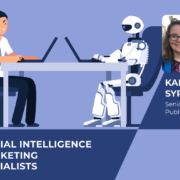How artificial intelligence can aid marketing and PR specialists
The use of artificial intelligence (AI) in various fields of human activity is an extremely popular topic these days, and it is surrounded by much speculation. Let’s try to unpack how artificial intelligence solutions, such as ChatGPT and the like, can aid marketing and public relations (PR) specialists in their daily professional routines.
Copywriting, or text writing, is the most obvious field that AI can handle successfully. I spoke about the question of whether artificial intelligence could replace copywriters in detail in a previous article, and I can repeat my conclusion here: at the moment, it is not possible to entirely replace copywriters with AI tools, but even now, these tools may help copywriters and editors create and edit text at a decent level.
Another obvious way to use AI is in the quick search for required information and in aiding its interpretation. Artificial intelligence tools can find the information you need in a moment, “recite” it, and, if needed, help you interpret it.
AI tools can generate various ideas that can be used to a certain extent in solving marketing problems: strategy writing, script writing for videos and podcasts, preparation of graphic images for advertising and other purposes and for marketing event plans, creation of slogans (but this is rather close to copywriting, mentioned above), etc.
Another scope for the application of AI is in linguistic translation. Such tools are very useful in cases in which it is necessary to translate the required content immediately for at least a basic understanding of it, because they give specialists an opportunity to find new information presented in almost any foreign language, and thus, discover a large fount of knowledge. It is important to remember that the suggested translation cannot replace one done by an expert (human), which is of course, provided by professional language providers.
Voiceovers and subtitling for them are closely related to the previous point about translation. AI tools can create subtitles for videos in a required foreign language, as well as do voiceovers.
Image generation is another example of the use of artificial intelligence. There are AI tools that can create interesting and unusual images in a variety of styles based on text prompts they receive.
This article features examples using AI tools that are publicly accessible and generally free. More complex tools can help specialists do more complex tasks.
In conclusion, it is worth mentioning that artificial intelligence should be treated as an aide and a friend, and that it is necessary to thoroughly analyze any content or answer to a question it suggests. In other words, AI can be a source of inspiration, but everything it suggests should be seen through the prism of your own perception.
Janus Worldwide takes pleasure in using the latest technologies, tools, and solutions in its work. Recently, Janus Worldwide launched its AI Taskforce project dedicated to the integration of large language models (LLMs) and generative artificial intelligence (GenAI) into the company’s business processes.






